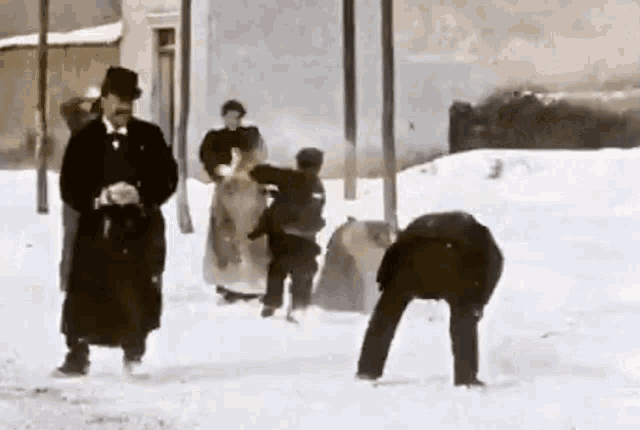During the tough winter months, we can all use some play. Plus, who doesn't love activities that are FUN for kids, can be done at a distance, AND which are low-prep for teachers? Enter: the snowball fight. |
| A short clip, originally captured by Louis Lumière in 1896, documents a rowdy snowball fight on the streets of Lyon, France. |
Teachers often put pressure on themselves to come up with unique and creative activities for their classes. And while these memorable activities are valuable, there is also value to using routines and predictable strategies that put students in charge of the learning activity. While not exactly a routine, the snowball fight "strategy" can be deployed in many different ways, some of which are very low prep, and some of which can be deployed in the moment when you need (or want) to fill time with meaningful learning activities.
So what is it?
To have a snowball fight in the classroom, simply give each student a piece of paper, have students crumple the paper up, and then throw it around the room. After you stop the snowball fight, each student picks up one of the snowballs and is responsible for doing something with that sheet of paper. Then, students crumple up their snowball and play again!
Classroom Management Note: You will want to give clear guidelines to manage the mess and keep students safe (i.e. no throwing at the plants, no tight wads that would sting, don't throw at people, etc.). You might also use the balls in a manner more akin to bowling, avoiding throwing in rooms where kids can't handle airborne objects!
Teaching Made Practical clarifies that this strategy works well for retrieval/practice and sorting/comparison. Both of these are high-yield teaching practices!
"A Quick Review - On each snowball, I would write something that students should be able to answer very quickly like a math problem or a sight word. After the snowball fight, each student would quickly answer the question on their snowball before playing again.
Sometimes I would have students partner up to answer their questions, and other times I would have everybody bring their snowball to the carpet and they would share their answer one at a time so I could quickly assess everybody.
A Sorting/Categorization Activity - I would hang "category" signs around the room and each snowball would have a number or sentence that would fit in one of the categories. After the snowball fight, students would open their snowball and decide which category they belonged to."
The Teaching to the Top podcast shared several ideas for this strategy. With a little prep, the teacher can pass out papers with different problems, words, or topics related to the learning targets:
- In math class, students might solve the problem on the first turn, and on the second turn, they might solve the problem a different way.
- In English, the teacher might put different characters on paper, and students would add traits to the characterization (perhaps with evidence) on each throw.
- Any class can use this to review content area vocabulary, adding a synonym, example, sentence, etc. to the paper each time they pick one up. You could even use a Freytag organizer and have students complete one part of it on each throw, exposing them to many words over the course of the game.
This could also be used for peer review of short drafts. For example, students might create a word problem that results in a given number as an answer, and their peers have to provide feedback on the quality of the problem. Students might likewise create sentences with certain characteristics, and their peer then "annotates" the sentence for the required features.
The Beakers and Ink blog shared this idea for adding more writing to the science classroom, but which would work across disciplines: ask students to write several sentences about what they just learned, watched, read about, etc. Then, snowball! Students pick up and read, maybe writing a response suggesting a change or addition. And they can repeat or return the ball to the owner.
"Not only are they practicing summarizing new information, but they are sharing and reading multiple summaries!"
This Edutopia video shows how this strategy can also be used for an end of class debrief, but with an SEL twist:
There are so many ways to use this strategy, many as simple as giving game guidelines and putting the students in charge of writing something on a piece of paper. While not fancy, this fun strategy can be used over and over again for high quality learning. How do you see this working in your classroom?

No comments:
Post a Comment
Have something to ask or add? Let us know! We have moderation turned on (just in case), but we will be sure to approve new comments each week day.